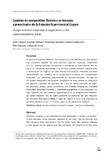Mostrar el registro sencillo del ítem
Cambios de composición florística en bosques aprovechados de la Estación Experimental Caparo
| dc.rights.license | http://creativecommons.org/licenses/by-nc-sa/3.0/ve/ | |
| dc.contributor.author | Lozada, José Rafael | |
| dc.contributor.author | Arends, Ernesto | |
| dc.contributor.author | Sánchez, Domingo | |
| dc.contributor.author | Villarreal, Alberto | |
| dc.contributor.author | Soriano, Pilar | |
| dc.contributor.author | Costa, Manuel | |
| dc.date.accessioned | 2013-04-29T15:58:46Z | |
| dc.date.available | 2013-04-29T15:58:46Z | |
| dc.date.issued | 2013-04-29T15:58:46Z | |
| dc.identifier.issn | 0798-2437 | |
| dc.identifier.uri | http://www.saber.ula.ve/handle/123456789/36981 | |
| dc.description.abstract | El aprovechamiento selectivo de maderas es una perturbación que genera una sucesión vegetal. En este proceso algunas especies, adaptadas a la luz, pueden resultar favorecidas y aumentan su importancia. Por su parte, las especies adaptadas a la sombra pueden resultar perjudicadas y disminuyen. El objetivo de este trabajo fue evaluar, mediante parcelas permanentes, los cambios en la composición florística en comunidades forestales con diferentes intensidades de aprovechamiento. Se ejecutó un diseño estadístico de bloques completos al azar, donde se evaluaron los árboles y palmas en parcelas de 1 ha. En estos bosques de bajío, las parcelas testigo están dominadas por Attalea butyracea, Pouteria reticulata, Spondias mombin y Trichantera gigantea. En las parcelas con bajo impacto, no hay cambios significativos en la composición florística. En medio impacto, hay un ligero aumento de pioneras. En alto impacto, las pioneras Cecropia peltata e Inga sp. llegan a tener una importancia conjunta de 20%, a los 11-13 años, pero ya se observa su declive. | es_VE |
| dc.language.iso | es | es_VE |
| dc.rights | info:eu-repo/semantics/openAccess | |
| dc.subject | Manejo forestal | es_VE |
| dc.subject | Sucesión vegetal | es_VE |
| dc.subject | Llanos Occidentales | es_VE |
| dc.title | Cambios de composición florística en bosques aprovechados de la Estación Experimental Caparo | es_VE |
| dc.title.alternative | Changes of floristic composition in logged forests at the Caparo Experimental Station | es_VE |
| dc.type | info:eu-repo/semantics/article | |
| dc.description.abstract1 | Selective logging is an interference that generates a forest succession. In this process, some species, adapted to the light, can be favored and they increase their importance. On the other hand, the species adapted to the shade can be injured and they diminish. The objective of this work was to evaluate, by means of permanent plots, the changes in the floristic composition in forest communities with different logging intensities. A statistical design of random complete blocks was executed, where the trees and palms were evaluated in 1 ha plots. In these clay soil forests, the control plots are dominated by Attalea butyracea, Pouteria reticulata, Spondias mombin and Trichantera gigantea. In low impact plots, there are not significant changes in the floristic composition. In medium impact, there is a slight increase of pioneers. On high impact, the pioneers Cecropia peltata and Inga sp. reach a combined importance of 20%, to the 11-13 years, but their decline is already observed. | es_VE |
| dc.description.colacion | 35-50 | es_VE |
| dc.description.email | jolozada@ula.ve | es_VE |
| dc.identifier.depositolegal | 198102ME433 | |
| dc.subject.facultad | Facultad de Ciencias Forestales y Ambientales | es_VE |
| dc.subject.institutoinvestigacion | Instituto Forestal LatinoAmericano (IFLA) | |
| dc.subject.keywords | Forest management | es_VE |
| dc.subject.keywords | Forest succession | es_VE |
| dc.subject.keywords | Western plains | es_VE |
| dc.subject.publicacionelectronica | Revista Forestal Latinoamericana | |
| dc.subject.seccion | Revista Forestal Latinoamericana: Artículos | es_VE |
| dc.subject.thematiccategory | Geografía | es_VE |
| dc.subject.thematiccategory | Medio Ambiente | es_VE |
| dc.subject.tipo | Revistas | es_VE |
| dc.type.media | Texto | es_VE |
Ficheros en el ítem
Este ítem aparece en la(s) siguiente(s) colección(ones)
-
Revista Forestal Latinoamericana - Vol 024 (2) - Nº 46
Julio - Diciembre 2009


